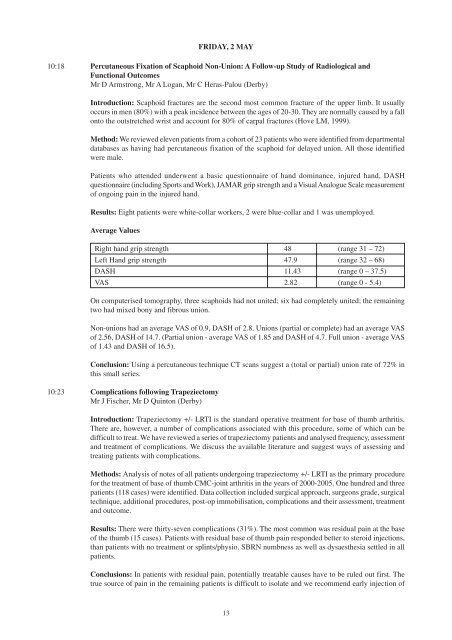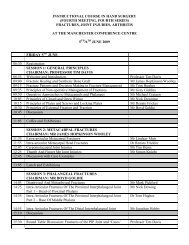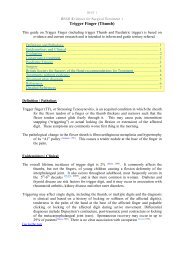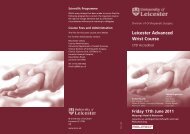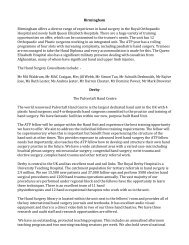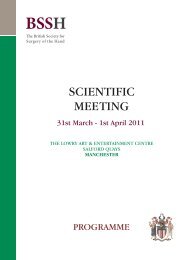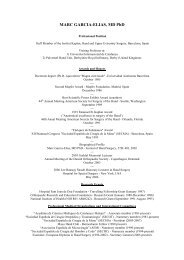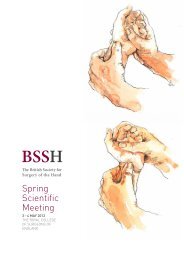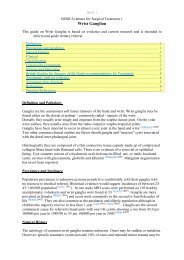here - The British Society for Surgery of the Hand
here - The British Society for Surgery of the Hand
here - The British Society for Surgery of the Hand
You also want an ePaper? Increase the reach of your titles
YUMPU automatically turns print PDFs into web optimized ePapers that Google loves.
FRIDAY, 2 MAY<br />
10:18 Percutaneous Fixation <strong>of</strong> Scaphoid Non-Union: A Follow-up Study <strong>of</strong> Radiological and<br />
Functional Outcomes<br />
Mr D Armstrong, Mr A Logan, Mr C Heras-Palou (Derby)<br />
Introduction: Scaphoid fractures are <strong>the</strong> second most common fracture <strong>of</strong> <strong>the</strong> upper limb. It usually<br />
occurs in men (80%) with a peak incidence between <strong>the</strong> ages <strong>of</strong> 20-30. <strong>The</strong>y are normally caused by a fall<br />
onto <strong>the</strong> outstretched wrist and account <strong>for</strong> 80% <strong>of</strong> carpal fractures (Hove LM, 1999).<br />
Method: We reviewed eleven patients from a cohort <strong>of</strong> 23 patients who were identified from departmental<br />
databases as having had percutaneous fixation <strong>of</strong> <strong>the</strong> scaphoid <strong>for</strong> delayed union. All those identified<br />
were male.<br />
Patients who attended underwent a basic questionnaire <strong>of</strong> hand dominance, injured hand, DASH<br />
questionnaire (including Sports and Work), JAMAR grip strength and a Visual Analogue Scale measurement<br />
<strong>of</strong> ongoing pain in <strong>the</strong> injured hand.<br />
Results: Eight patients were white-collar workers, 2 were blue-collar and 1 was unemployed.<br />
Average Values<br />
Right hand grip strength 48 (range 31 – 72)<br />
Left <strong>Hand</strong> grip strength 47.9 (range 32 – 68)<br />
DASH 11.43 (range 0 – 37.5)<br />
VAS 2.82 (range 0 - 5.4)<br />
On computerised tomography, three scaphoids had not united; six had completely united; <strong>the</strong> remaining<br />
two had mixed bony and fibrous union.<br />
Non-unions had an average VAS <strong>of</strong> 0.9, DASH <strong>of</strong> 2.8. Unions (partial or complete) had an average VAS<br />
<strong>of</strong> 2.56, DASH <strong>of</strong> 14.7. (Partial union - average VAS <strong>of</strong> 1.85 and DASH <strong>of</strong> 4.7. Full union - average VAS<br />
<strong>of</strong> 1.43 and DASH <strong>of</strong> 16.5).<br />
Conclusion: Using a percutaneous technique CT scans suggest a (total or partial) union rate <strong>of</strong> 72% in<br />
this small series.<br />
10:23 Complications following Trapeziectomy<br />
Mr J Fischer, Mr D Quinton (Derby)<br />
Introduction: Trapeziectomy +/- LRTI is <strong>the</strong> standard operative treatment <strong>for</strong> base <strong>of</strong> thumb arthritis.<br />
T<strong>here</strong> are, however, a number <strong>of</strong> complications associated with this procedure, some <strong>of</strong> which can be<br />
difficult to treat. We have reviewed a series <strong>of</strong> trapeziectomy patients and analysed frequency, assessment<br />
and treatment <strong>of</strong> complications. We discuss <strong>the</strong> available literature and suggest ways <strong>of</strong> assessing and<br />
treating patients with complications.<br />
Methods: Analysis <strong>of</strong> notes <strong>of</strong> all patients undergoing trapeziectomy +/- LRTI as <strong>the</strong> primary procedure<br />
<strong>for</strong> <strong>the</strong> treatment <strong>of</strong> base <strong>of</strong> thumb CMC-joint arthritis in <strong>the</strong> years <strong>of</strong> 2000-2005. One hundred and three<br />
patients (118 cases) were identified. Data collection included surgical approach, surgeons grade, surgical<br />
technique, additional procedures, post-op immobilisation, complications and <strong>the</strong>ir assessment, treatment<br />
and outcome.<br />
Results: T<strong>here</strong> were thirty-seven complications (31%). <strong>The</strong> most common was residual pain at <strong>the</strong> base<br />
<strong>of</strong> <strong>the</strong> thumb (15 cases). Patients with residual base <strong>of</strong> thumb pain responded better to steroid injections,<br />
than patients with no treatment or splints/physio. SBRN numbness as well as dysaes<strong>the</strong>sia settled in all<br />
patients.<br />
Conclusions: In patients with residual pain, potentially treatable causes have to be ruled out first. <strong>The</strong><br />
true source <strong>of</strong> pain in <strong>the</strong> remaining patients is difficult to isolate and we recommend early injection <strong>of</strong><br />
13


